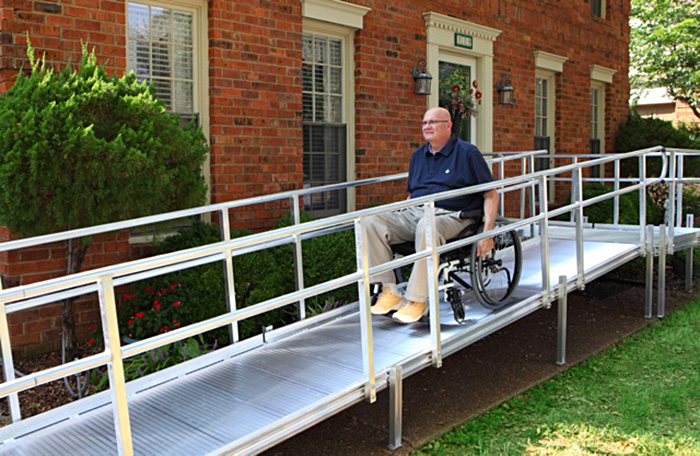Introduction
Welcome to your comprehensive guide to wheelchair ramps, the unsung heroes of accessibility. These essential tools are the bridge between mobility and independence for those who use wheelchairs, providing an accessible route where stairs would otherwise be a barrier. We will delve into the different types, materials, and design considerations to provide you with a well-rounded understanding of ramps.
Understanding the Importance of Accessibility
Empowering Individuals
The primary purpose of a wheelchair ramp is to empower individuals with disabilities, facilitating their movement in and out of buildings, vehicles, and other areas otherwise challenging to navigate. This empowerment extends beyond mere physical mobility—it encompasses social inclusion, self-reliance, and the overall quality of life.
Compliance with Legislation
Governments worldwide recognize the importance of accessibility, as reflected in laws such as the Americans with Disabilities Act (ADA) in the U.S. Compliance with such regulations not only supports those with mobility impairments but also showcases societal inclusivity. It is thus essential to understand and implement correct ramp specifications.
Different Types of Wheelchair Ramps
There are several types of ramps to consider, each offering its advantages based on specific needs and circumstances.
Portable Ramps
Portable ramps are lightweight, compact, and easily transportable, making them perfect for temporary or travel needs. They are ideal for bridging small steps or getting wheelchairs into vehicles.
Threshold Ramps
Designed to help wheelchairs overcome doorways or sliding door tracks, threshold ramps are smaller and typically fixed in place. They make the transition between different floor surfaces smooth and manageable.
Modular Ramps
Modular ramps are designed for more permanent installations, like homes or businesses. They are usually made from durable materials and can handle more weight. These ramps are customizable, allowing for the perfect fit for various spaces.
Vehicle Ramps
Specifically designed for accessibility to vehicles, these ramps can be permanent fixtures on adapted vehicles or portable for standard cars.
Click here – Pure Smiles – Dental Implants: what you need to know
Materials and Maintenance
Ramps can be constructed from a variety of materials, each with its own set of pros and cons.
Aluminum
Aluminium is lightweight yet durable, making it an excellent material for portable and modular ramps. It is rust-resistant and generally requires less maintenance than other materials.
Wood
Wooden ramps can be aesthetically pleasing, but they require regular maintenance to prevent rot and decay. Additionally, they can become slippery when wet, necessitating the use of non-slip surfaces.
Steel
Steel ramps are incredibly sturdy and can support heavy loads. However, they can rust if not properly maintained and are typically heavier than other options.
Design Considerations
When designing a ramp, there are several factors to take into account to ensure safety and usability.
Slope and Rise
The ADA recommends a slope ratio of 1:12 for wheelchair ramps, which means for every 1 inch of vertical rise, there should be 12 inches (or 1 foot) of the ramp. The gentler the incline, the safer and easier it will be to use the ramp.
Width
The minimum width of a wheelchair ramp should be 36 inches. This width provides ample space for all types of wheelchairs and gives users enough room to maneuver comfortably.
Handrails and Edge Protection
Handrails are crucial for user stability and safety, especially on longer ramps. Furthermore, edge protection or curbs can prevent wheelchairs from slipping off the side.
In the journey toward creating an inclusive society, wheelchair ramps are indispensable. Understanding the types, materials, and design considerations can help make buildings and transportation more accessible for everyone. As we continue to push the boundaries of accessibility, it’s clear that ramps for wheelchairs aren’t just pathways—they are vital lifelines that connect people to the world.
Innovative Developments in Wheelchair Ramp Design
In a world where technological advancements are continually transforming our lives, it’s only fitting that this extends to wheelchair accessibility too. These developments aim to increase convenience, safety, and independence for wheelchair users.
Smart Ramps
The next generation of ramps includes smart ramps, designed with embedded sensors and connected technology. These ramps can detect environmental conditions such as ice or rain and warm up to prevent freezing or become illuminated for enhanced visibility.
Portable Telescopic Ramps
For the frequent traveller, telescopic ramps have made accessibility more transportable than ever. These ramps can extend and retract, making them adjustable to various heights and compact enough to carry easily.
Adjustable Modular Ramps
Adjustable modular ramps are breaking new ground by offering an adaptable solution to varying situations. Users can modify these ramps’ length and slope, providing the flexibility to meet different accessibility requirements.
Purchasing Considerations
When purchasing a wheelchair ramp, it’s crucial to consider the user’s unique needs.
Assess the Environment
Examine the environment where you plan to use the ramp. Measure the height of any steps or thresholds to ensure you choose a ramp with the appropriate length and incline.
Consider Mobility Aid
Different mobility aids, such as manual wheelchairs, power wheelchairs, or scooters, might interact differently with various ramp types. Ensure the chosen ramp is suitable for the specific mobility aid used.
Consult a Professional
When in doubt, consult a professional. Occupational therapists, physical therapists, or accessibility consultants can provide valuable insights into the best ramp for specific needs and environments.
Conclusion
Wheelchair ramps have come a long way from simple inclined planes. Today, they are carefully engineered accessibility tools integral to the lives of individuals who use wheelchairs. Understanding the types, materials, and design considerations can help us create a world where every building, every vehicle, and every public space is accessible to all. The future of accessibility is bright, and it’s only getting brighter.

